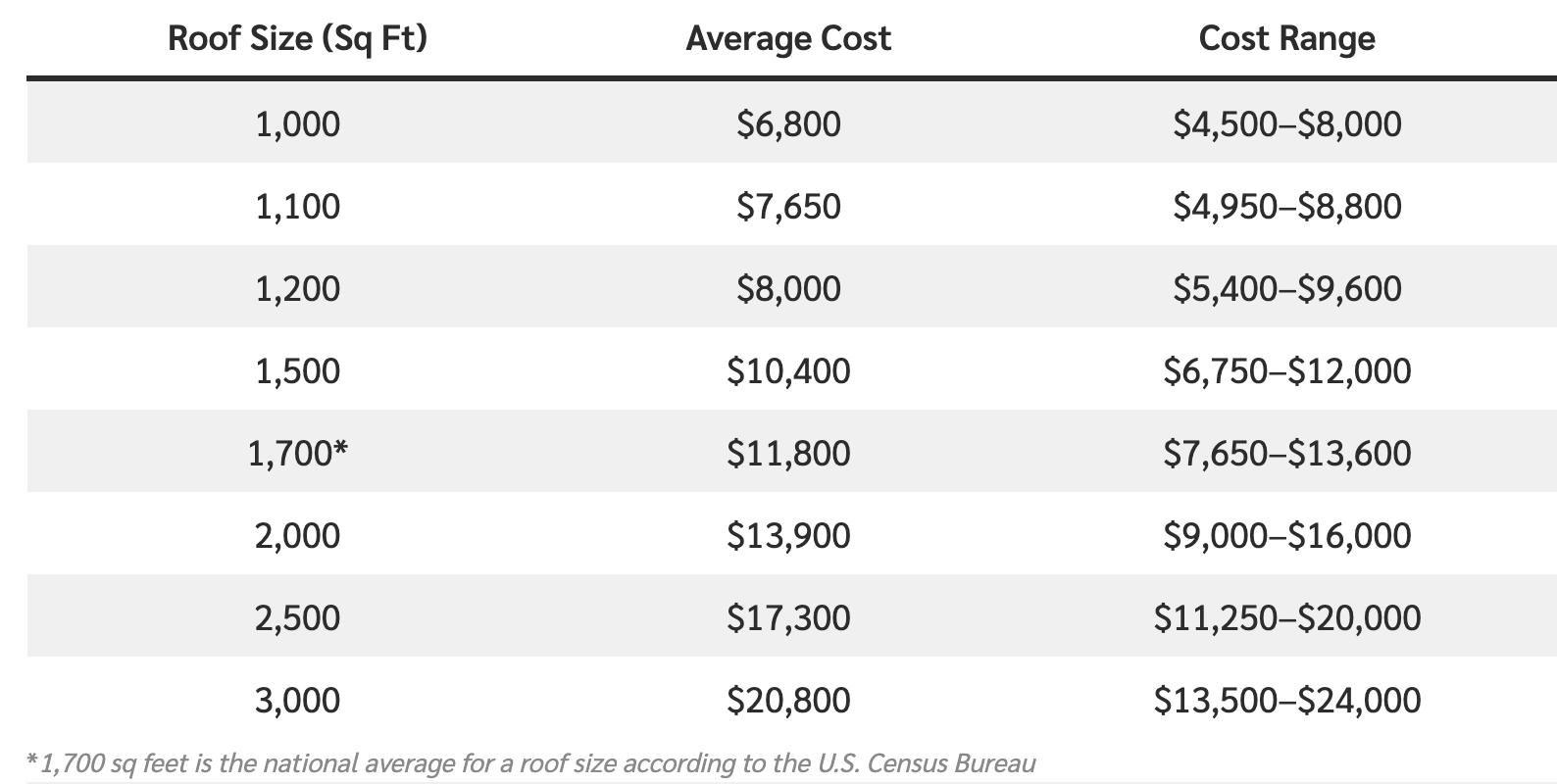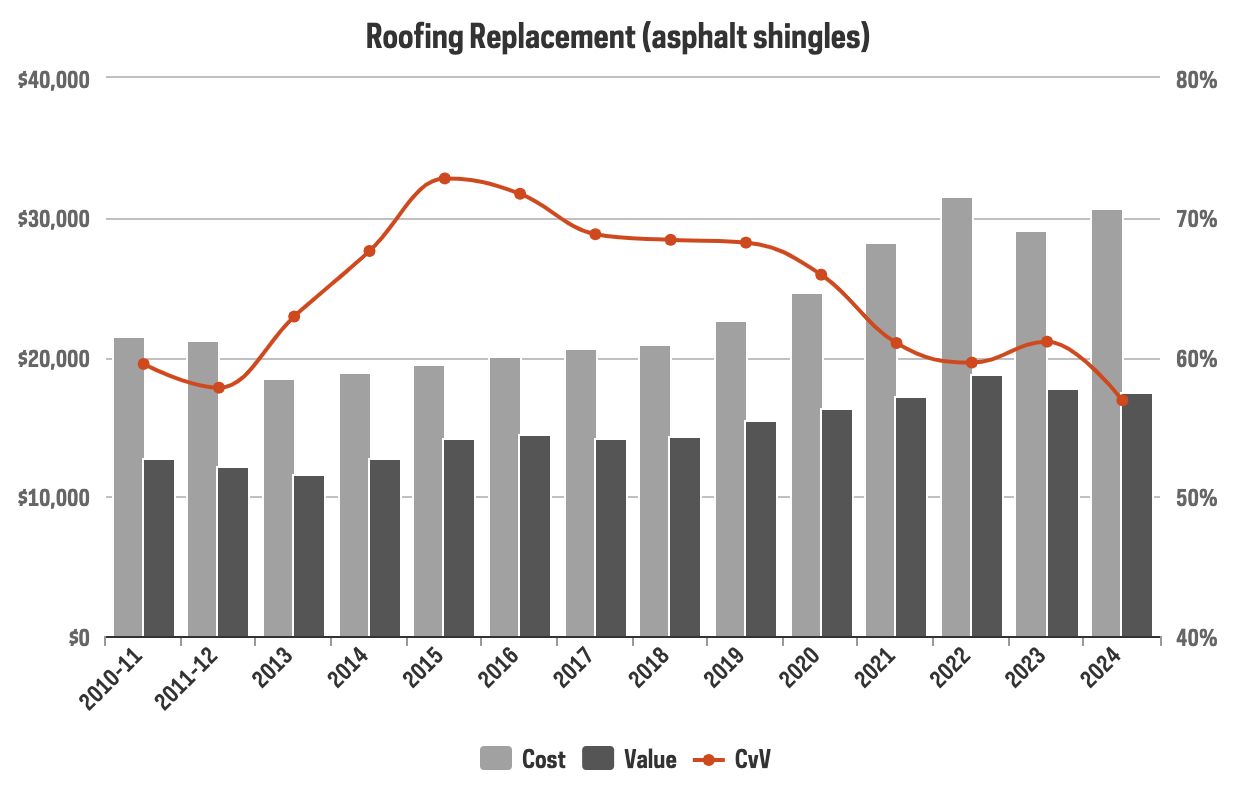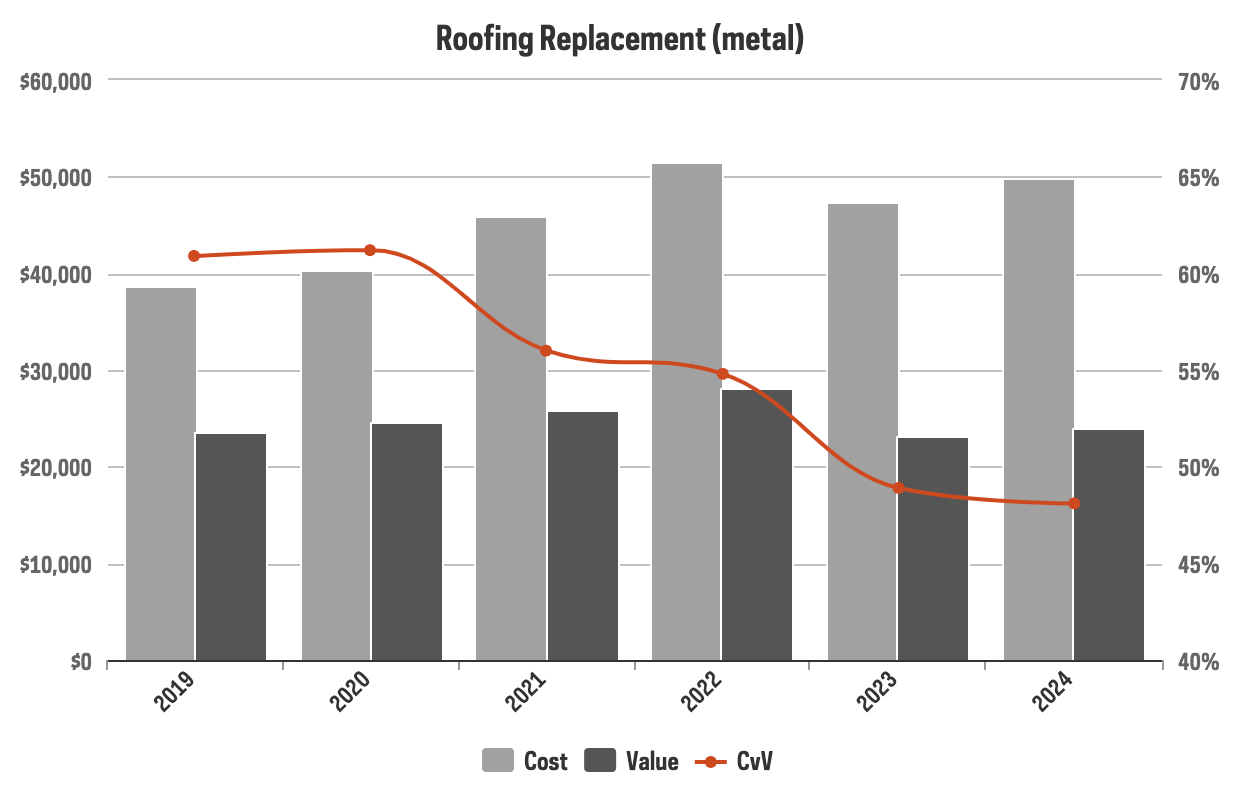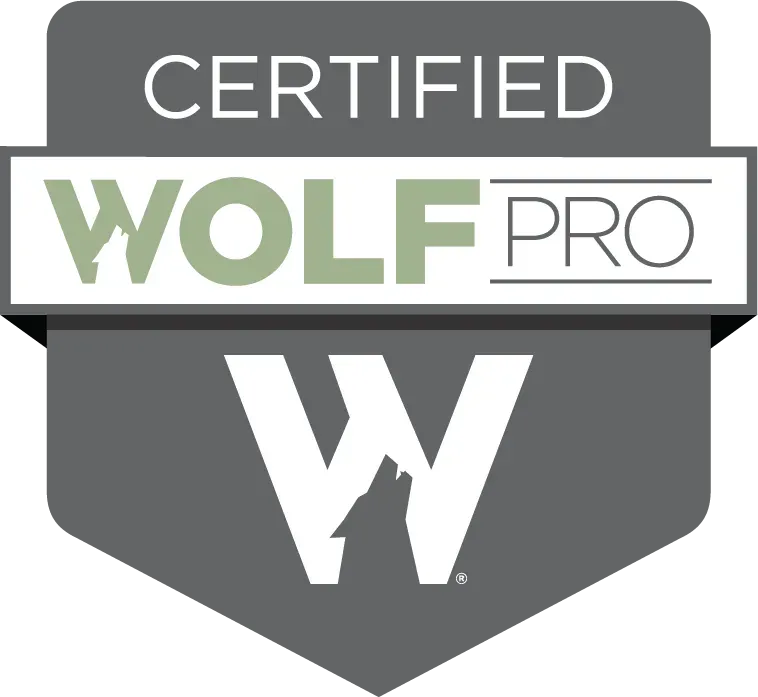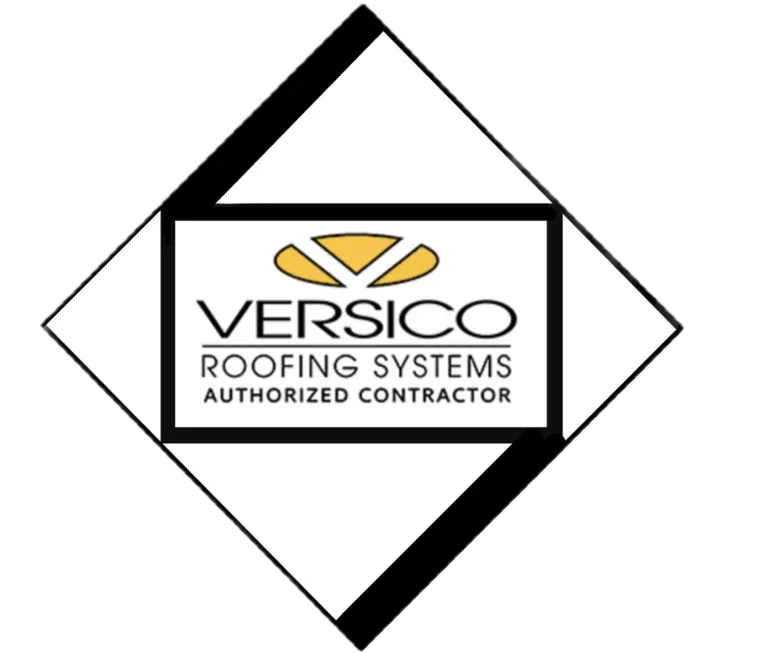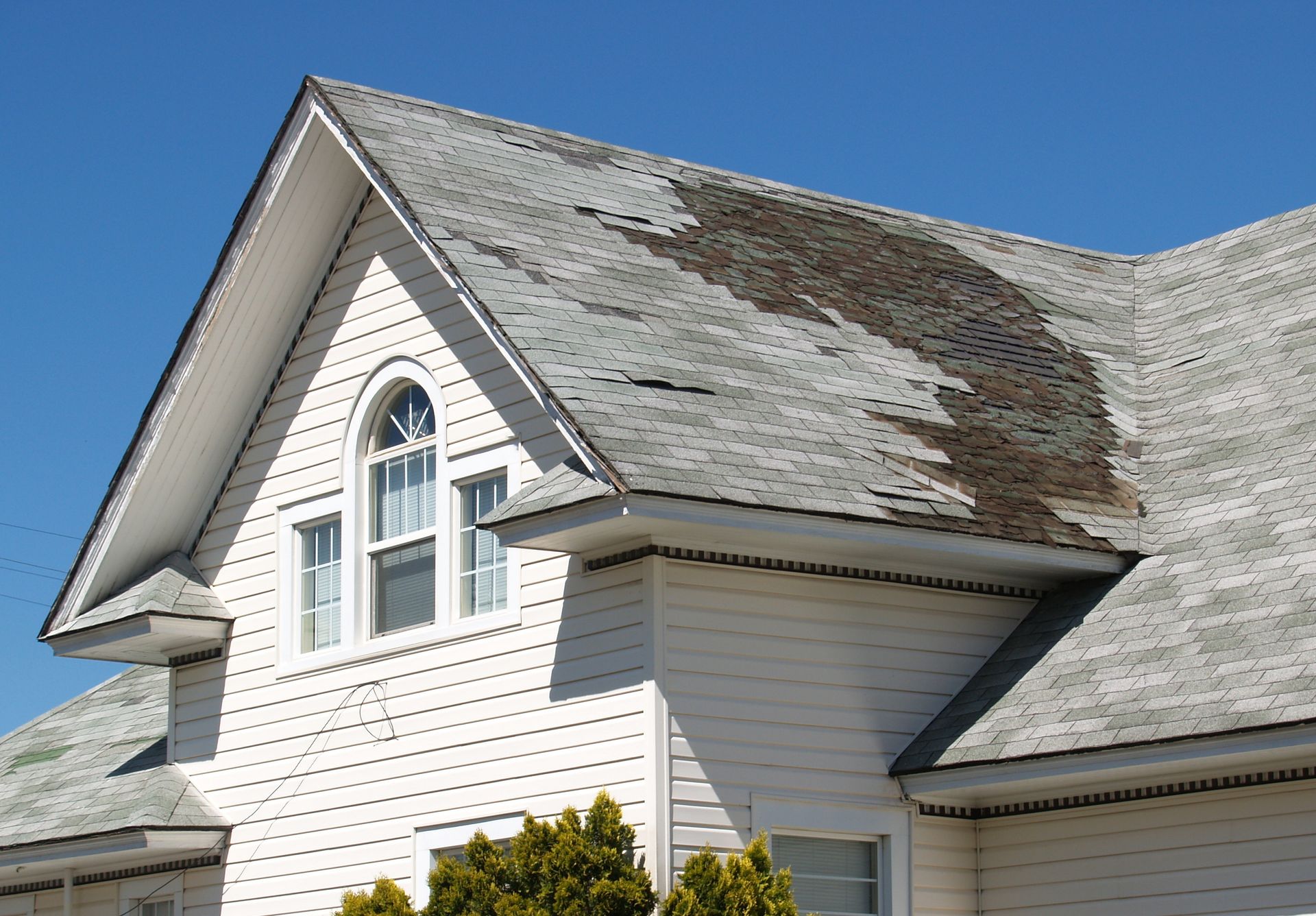How Much Does A New Roof Cost In Pennsylvania?
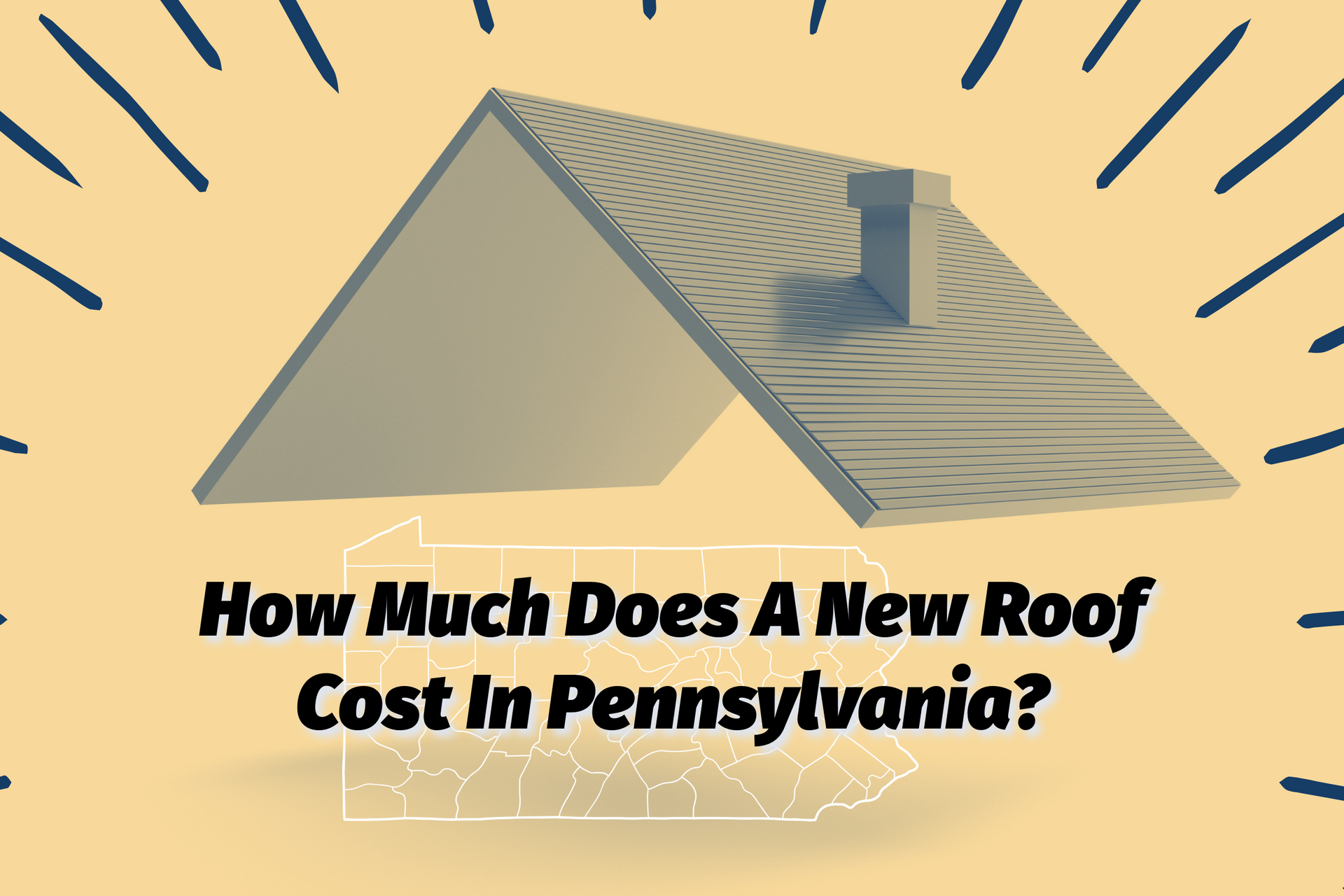
Introduction:
When repairing or replacing a damaged roof or fitting a new roof as part of a building or renovation project, it’s natural to ask questions about new roof costs and the average price of roof replacement. In this informative guide, we’ll answer all your questions about how much a new roof costs in Pennsylvania, explain which factors impact costs, including the materials you choose, where you live and the size of the roof, and share tips to help you bring down the total price and find the best roofing contractors for the job.
Table of Contents (Clickable):
Average Cost Of A New Roof In Pennsylvania
Figure 1: Table of Costs For Replacing Shingle Roofs Of Different Sizes In PA (US Census data)
How Do Pennsylvania Roof Costs Compare To Other States?
Figure 2: 2024 Cost Vs. Value Chart For Shingle Roof Replacement In The US
Figure 3: 2024 Cost Vs. Value Chart For Standing Seam Metal Roof Replacement In The US
Post Covid Rising Roof Material Costs
Key Factors Affecting The Cost Of A New Roof In Pennsylvania
1) Roof Size
2) Roof & Jobsite Complexity
The Impact Of Roof Pitch On Cost
Figure 4: Relationship Between Roof Pitch & Cost of Roof Replacement
The Impact Of Roof Hips On Cost
Figure 5: Relationship Between Roof Hips, Material Waste & Roof Replacement Cost
4) Roof Decking
6) Choice Of Roofing Contractor & Labor Costs
Choosing The Right Roofing Materials For Your Pennsylvania Home
2) Exposed Fastener Metal Roofing
3) Standing Seam Metal Roofing
9) Roll Roofing
Which Roofing Material Is Right For Me?
Tips To Save Money On Your New Roof
Average Cost Of A New Roof In Pennsylvania
The average cost of a new roof in Pennsylvania ranges according to the size of the roof, the materials, the roof design, location and choice of roofing contractor amongst other relevant factors. It’s beneficial to have an accurate idea of the average cost of roof replacement in your area, but it’s important to understand that every project is different.
According to data compiled by the US Census Bureau:
- The national average roof size is 1,700 square-foot or 17 SQ
- The most common type of residential roofing material is asphalt shingles
- Pennsylvania homeowners can expect to pay between $6.00 - $8.50 per square-foot of shingle roofing
Based on these numbers, a Pennsylvania homeowner with an average sized roof of 1,700 square-foot is likely to pay between $10,000 and $14,000 to replace their shingle roof. This coincides with estimates from the US Department of Energy indicating that the average cost to replace a shingle roof is $10,000 but can range anywhere between $8,500 to $14,300.
Note that these numbers are average estimates for a standard PA roof replacement project. If your requirements are more complex, you have a large property, or you choose premium roofing materials, the cost may be significantly higher.
The table below summarizes current US Census Data for the cost of replacing shingle roofing in Pennsylvania.
How Do Pennsylvania Roof Costs Compare To Other States?
Data from This Old House for 2025 suggests that the average cost in Pennsylvania is similar to average prices in California, Florida, Georgia, Illinois, Michigan, New York, North Carolina, Ohio, and Texas. It is important to note that average roof costs vary according to your location. Prices may be higher or lower than those in the table depending on where you live, whether in-state or out-of-state.
Nationally speaking, according to The Journal of Light Construction’s 2024 Cost Vs Value Report the average cost to replace a 3,000 square-foot asphalt shingle roof in the US is $30,680. This suggests a national average cost for replacing shingle roofing to be roughly $1,000 per SQ (or 100 square-foot), which is higher than Pennsylvania’s average shingle roofing costs of $700-$800 per SQ. For standing seam metal roofing, the figure increases to $49,928 for a 3,000 square-foot roof, which equates to an average cost of just under $1,700 per SQ.
Roof replacement and repairs represent a significant investment for home and business owners across the US. Before you spend money on your home or business premises, it’s essential to understand the costs involved. There are several key factors that influence roof replacement costs, which means the fee can range from less than $10,000 to more than $35,000. Understanding how pricing works and the elements involved in calculating costs will help you identify the best value quotes, budget for roof repairs or a new roof and choose suitable materials for your home.
Post Covid Rising Roof Material Costs
If the numbers cited here are higher than expected it’s because the cost of roofing materials have increased significantly since 2020. Sources suggest that prices rose by up to 45% between the start of the Covid pandemic and August 2023. In the last 18 months, there have been further increases, with the latest hike expected to impact costs by around 6% - 8% following January 2025. As vendors are still updating catalogs, the true increase in cost is not yet known. We’re expecting to see the full impact of this latest cost increase on roofing materials by March 2025.
Need A Roofing Quote?
At Rob's General Contracting we've been building roofing expertise since 1992 - Originally Rob's Roofing
Key Factors Affecting The Cost Of A New Roof In Pennsylvania
The cost of a new roof in Pennsylvania ranges significantly. The range is substantial because it reflects a multitude of factors that impact costs. Key factors to consider include:
1. Roof Size
Roof size is measured based on its surface area, which includes all sections of the roof, accounting for its shape and pitch (slope). Roofers typically measure the roof in
square-feet but discuss it in terms of
roofing squares (SQ), a standard unit in the industry.
Roofing Square:
• One roofing square (SQ) equals 100 square feet (sqft) of roof area.
• For example, a 2,000-square-foot roof is referred to as 20 roofing squares.
Measurements:
• Roofers often measure the length and width of each roof section and multiply these dimensions to calculate the total square footage.
• They also account for overhangs, dormers, and other architectural features.
Pitch Factor:
• The roof’s slope affects the actual surface area. Steeper roofs have more surface area than flat ones of the same footprint.
• Roofers use a pitch factor (based on the roof’s angle) to adjust measurements and ensure accurate material estimates.
The size of the roof is a major factor in determining the cost of a new roof in Pennsylvania. Generally, as size increases the total cost to replace the roof increases proportionately. It’s important to note, however, size isn’t the only consideration. Comparing the cost of replacing a larger roof to a smaller one doesn’t always mean the larger roof will be more expensive. Other key factors, such as the quality and durability of materials and the complexity of the project, also play a significant role in determining the overall cost.
On the other hand, as the size of a roofing project increases, the cost per roofing square (SQ) for materials and labor often decreases, similar to the concept of buying in bulk. This is because bigger roofs enable the crew to work more continuously, reducing the time spent on setup, cleanup, and transitions between jobsites. Essentially, overhead costs, like transportation and equipment setup, are distributed across more squares, lowering the per-square labor expense. Moreover, some costs, like the rental of a dumpster container, remain the same regardless of roof size (to an extent). For example, the cost to dispose of old roofing materials is often similar for a 10-square roof and a 20-square roof, which makes the per-square disposal cost lower on larger projects.
In summary, roof size and total replacement cost are positively correlated—larger roofs typically result in higher overall replacement costs. However, there is often an inverse correlation between roof size and the average cost per square (SQ). In practical terms, this means that if your shingle roof is larger than your neighbor’s, you’ll likely pay more in total for your replacement, but your cost per square may be lower than what your neighbor would pay per square for their smaller roof.
Measuring your roof’s square footage and researching the roof replacement costs of nearby neighbors can provide valuable insights into the overall expense.
2. Roof And Jobsite Complexity
Complexity is a key factor influencing the cost of a new roof in Pennsylvania, encompassing both the roof design and job site conditions.
The more intricate and detailed the roof design, the higher the cost. Complex installations often require specialized skills, increasing labor costs, and may take longer to complete, further adding to the total expense. Additionally, certain structural complexities can raise material requirements, increasing material costs. In some cases, premium materials may be recommended to address specific challenges, further impacting the quote. For example, skylights and chimneys can significantly impact the cost of a roof replacement. These features require extra labor to integrate seamlessly into the new roofing system and demand additional materials to ensure proper sealing and functionality.
The Impact Of Roof Pitch On Costs
One major roof complexity that directly affects replacement costs is roof pitch, or the steepness of the roof’s slope. Roof pitch is typically expressed as a ratio, such as 6:12, meaning the roof rises 6 inches for every 12 inches of horizontal run. Steeper roofs are generally more expensive to replace due to the added challenges they present.
As the pitch increases:
• The surface area of the roof becomes larger, requiring more materials.
• Labor becomes more demanding and hazardous, as steeper slopes are more difficult to work on safely.
For very steep roofs, crews often need to install
special jacks and planks, which act as safety platforms, enabling workers to move about the roof without slipping. These additional safety measures not only extend the time required to complete the job but also increase labor costs.
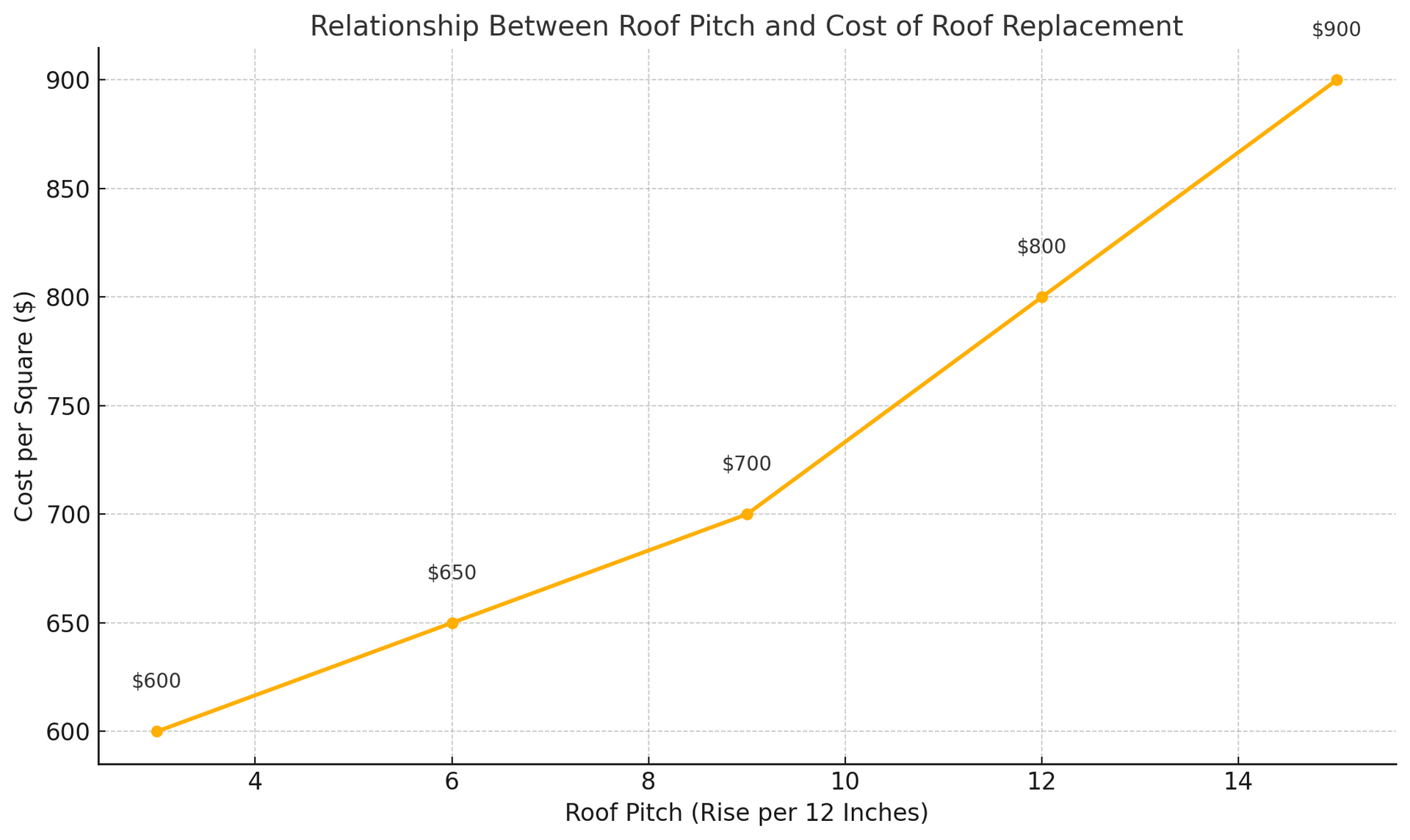
The Impact Of Roof Hips On Cost
A roof hip is the external angle or ridge formed where two sloping roof planes meet. Unlike valleys, which are internal intersections, hips are found on the outer edges of a roof. They typically run diagonally from the corners of the roof to the ridge at the top, forming a “sloped edge”.
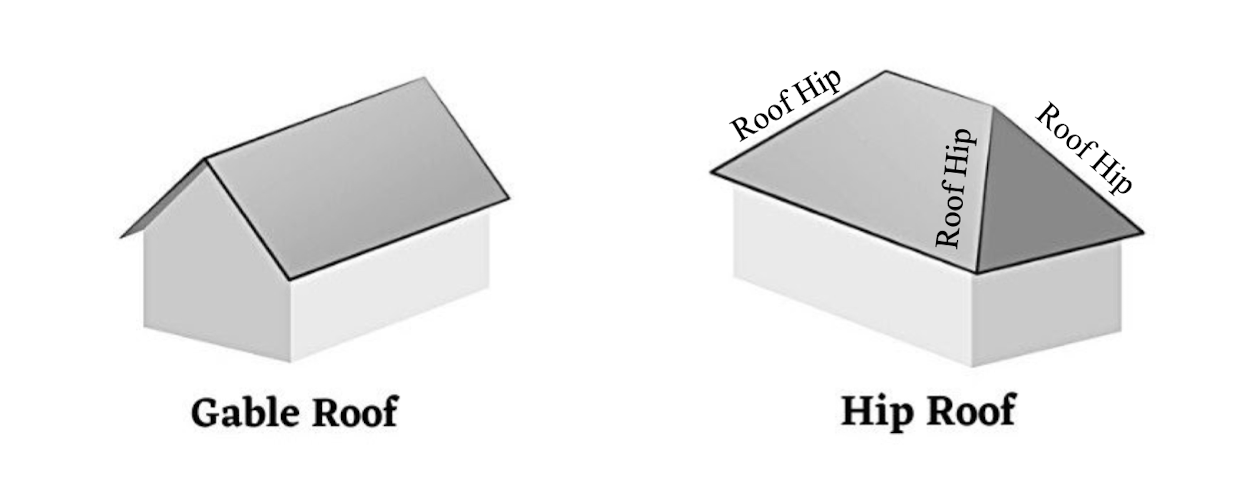
Roofs with more hips tend to have higher replacement costs due to the increased complexity they bring to a project. The design of a hip roof requires additional materials, such as ridge caps, and the way hips divide the roof into multiple sections creates more waste material. This happens because the cuts needed for fitting materials along the hips often result in leftover pieces that cannot be reused elsewhere.
The added labor involved in properly cutting and fitting materials along the hips also contributes to the cost. These areas demand precision and extra time to ensure a watertight seal, particularly as hips are critical points for potential leaks. Moreover, the intersecting roof planes in a hip design often require structural reinforcements, which further adds to the material and labor costs.
The slopes and angles of a hip roof can also make the installation process more challenging and time-consuming, especially on steeper roofs, increasing both the labor demand and safety considerations. Taken together, these factors—higher material usage, increased waste, added labor demands, and structural complexities—all contribute to the higher overall cost of replacing a roof with more hips.
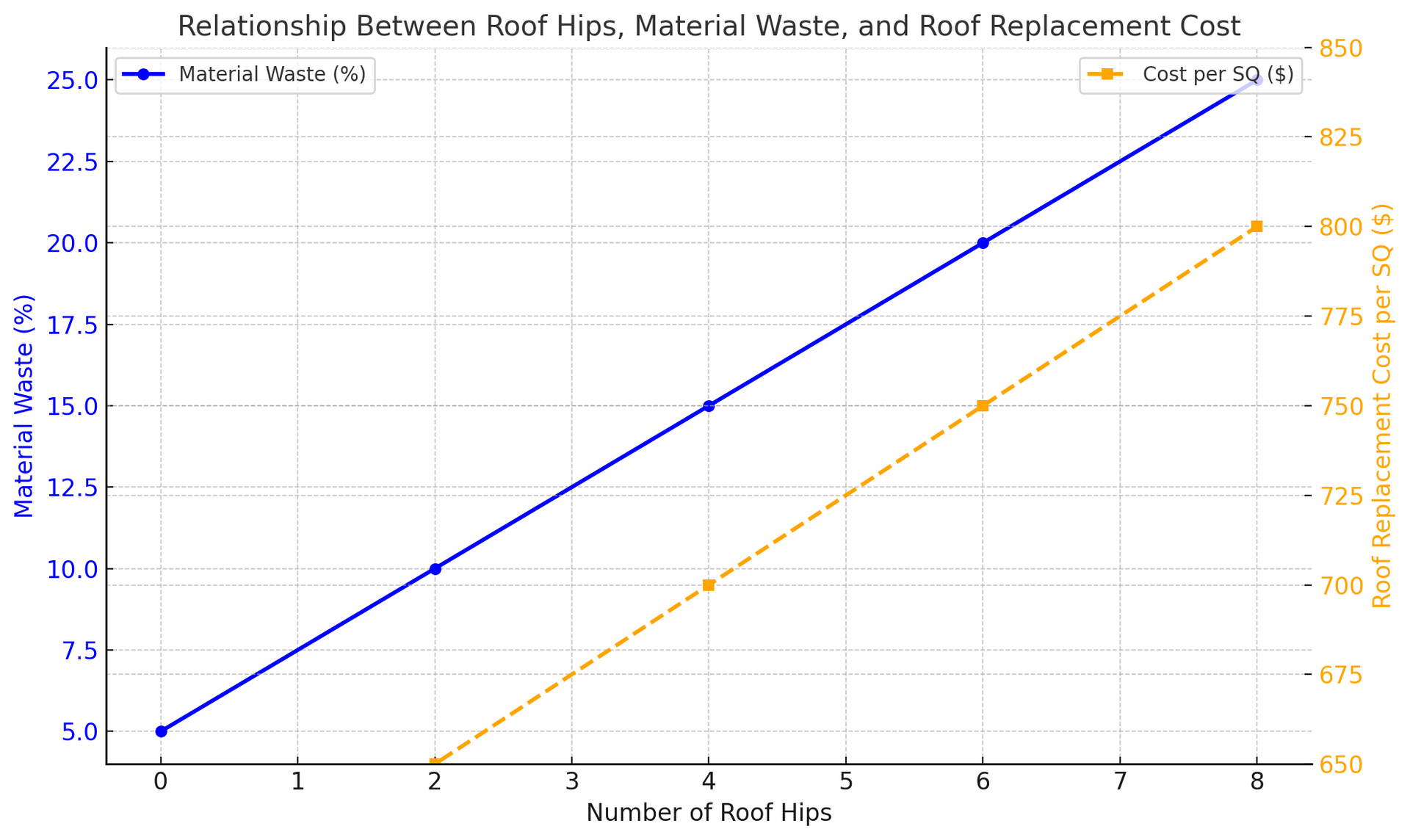
Jobsite Complexities
Job site conditions further impact costs. For example, if your building is surrounded by adjacent structures that limit rooftop access, or if the nearest location for a dumpster is 100 yards away through a narrow alley, these challenges add to the labor demands. Extra time and effort required to navigate such obstacles drive up labor costs, making job site complexities an essential consideration in pricing.
By understanding how roof and site complexities influence costs, homeowners can better anticipate pricing variations and appreciate the skill and effort required for complex roof replacements.
3. Types Of Roofing Materials
The type of roofing material you choose for your new roof will have a big impact on the price you pay. Some materials are more expensive than others and some are more difficult to install, which also increases costs. It’s wise to weigh up the pros and cons of different roofing materials before you decide which option to choose.
Materials with a higher initial outlay may be less appealing if you’re on a tighter budget, but there are often opportunities to save money or add value in the long term. It’s helpful to calculate short and long-term costs and potential savings to help you decide which material will work best for your home. If you plan to stay at the property for many years, for example, you may want to invest in the most durable and aesthetically pleasing materials, which cost more. If low costs are a priority, it makes sense to opt for the least expensive materials.
The table below highlights different roofing materials and their expected cost per SQ in Pennsylvania for 2025. Note that steep-slope roofing materials are grouped toward the top while low-slope (or "flat") roofing materials are grouped on the lower half.
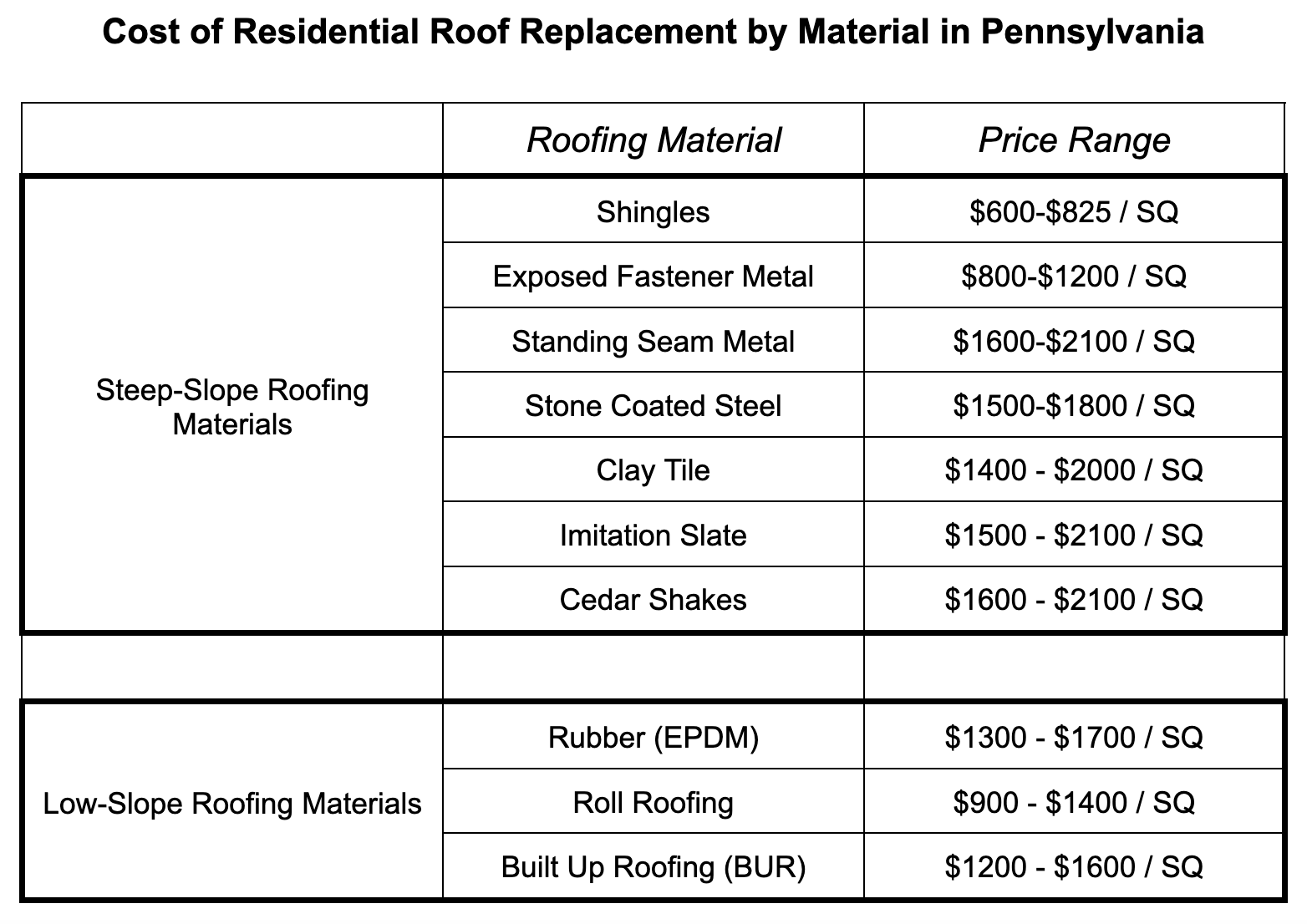
4. Roof Decking
Roof decking, the structural layer beneath your roofing materials, plays a crucial role in the overall cost of a roof replacement. It provides the foundation for shingles, metal panels, or other materials, and its condition directly impacts the durability and longevity of your roof.
If your existing roof decking is in good condition, the replacement cost may remain straightforward, as the new roofing can be installed without significant preparation. However, damaged, deteriorated, or spaced decking must be repaired or replaced to ensure the structural integrity of the roof. This additional work can significantly increase labor and material costs.
The type of decking material also influences costs. CDX Plywood and OSB (oriented strand board) are the most common and cost-effective options, but specialty materials, like tongue-and-groove planks, or thicker decking required for certain roofing systems can raise expenses. Additionally, code upgrades or reinforcement may be needed for homes in areas with specific wind, snow, or fire-resistance requirements.
Addressing roof decking issues is non-negotiable during a replacement project. A solid, properly installed deck ensures your roof performs as intended and avoids costly problems down the road. Investing in quality decking during a roof replacement is essential for long-term value and peace of mind.
5. Your Pennsylvania Location
Pennsylvania is a state that boasts a diverse range of properties located within a broad spectrum of sites, ranging from cosmopolitan cities and green suburbs to remote rural communities. The price of replacing or repairing your roof will vary, according to where you live in Pennsylvania. If you live in the heart of a bustling, modern city like Philadelphia, for example, you may find that labor costs are significantly higher than in rural areas due to the demand for skilled roofers.
In some Pennsylvania cities, performing work as a contractor requires obtaining a city-specific contractor license, which can add to roofing costs. For instance, in Scranton, contractors must secure a Scranton City Contractor License by paying fees, submitting documentation, providing references, and passing an exam annually.
Your location can also significantly influence the cost of a new roof, particularly if your home is in a historical district. Homes with “historical building” designation must comply with strict guidelines established by either a Homeowner’s Association (HOA) or the municipality’s historical district office. These rules often limit changes to a building’s exterior components which includes the type of roofing materials. As an example, if your historical home has a cedar shake roof that needs replacement, regulations will likely require you to use the same cedar shake material, one of the most expensive roofing options. In such cases, less costly alternatives like asphalt shingles would not be permitted, potentially leading to higher expenses for your roof replacement. Compliance with these preservation standards ensures the historical character of the property is maintained but can significantly impact the overall project cost.
Other location-based factors such as property accessibility, local building codes and the availability of specific roofing materials can also affect the cost to replace your roof. Learning more about the importance of your location within Pennsylvania can help you estimate roof replacement costs more accurately based on where you live.
6. Choice of Roofing Contractor & Labor Costs
The cost of a new roof in Pennsylvania depends heavily on labor costs and the contractor you choose to carry out the work on your home. Experienced roofers may charge more than novices and in most cases, you pay a premium for first-class craftsmanship. To find the best value quote, it’s beneficial to contact multiple contractors to get quotes for your new roof. This will enable you to compare prices and services and get a better idea of what different contractors offer.
It’s wise to prioritize value for money over costs when comparing quotes from roofing companies. If you can afford to pay for the finest materials and the most experienced contractors, for example, there’s a higher chance of achieving the best quality finish, which will save you money in the long term. This is particularly beneficial if you’re keen to add value to your Pennsylvania home or you plan to stay at the same property for several years.
7. Roof Warranties
Deciding whether to include a roof warranty in your replacement project can significantly impact the overall cost. Roof warranties come in two main types: manufacturer warranties, which cover defects in the roofing materials, and workmanship guarantees, which cover installation errors.
Opting for a warranty often increases the upfront cost of a new roof but provides long-term value and peace of mind. For example,
premium manufacturer warranties, such as those offering lifetime coverage, may require using certified contractors and specific materials, which can elevate costs. However, these warranties often include additional benefits like enhanced material performance and coverage for labor in case of defects.
At Rob’s General Contracting, we take pride in being
GAF Certified Residential Roofing Contractors and prodigious advocates of
the GAF Lifetime Roofing System. When homeowners need a shingle roof replacement, we typically provide 2–3 estimates to ensure they have options. One of these estimates always features the GAF Lifetime Roofing System, which includes an enhanced lifetime warranty for comprehensive peace of mind. Another estimate presents a more basic option without a uniform roofing system or warranty.
While the GAF Lifetime Roofing System estimate is
usually higher in cost, we strongly recommend it for its superior quality, durability, and long-term value. Most of our customers recognize the exceptional benefits of investing in this system and choose it to protect their homes.
Workmanship guarantees can also influence costs, as contractors who offer extended or guaranteed workmanship often have higher pricing to reflect their expertise and commitment to quality. These warranties protect against issues like improper installation, which can save you from costly repairs down the road.
With over 30+ years of experience as a family-owned roofing company, we confidently stand behind our work - which is why we offer a "Rob's GC 10-Year Workmanship Guarantee" on ALL roof replacement projects at no extra cost.
If you're on a tight budget, choosing not to include a warranty may reduce your initial costs when getting a new roof for your home. That being said, doing so places you at a greater risk of paying more costs later. Without a warranty, you’ll bear the full cost of any future repairs or replacements caused by material failure or installation errors.
Ultimately, investing in a roof warranty can raise your upfront costs but offers valuable protection, ensuring your roof’s durability and minimizing unexpected expenses in the long term. It’s essential to weigh the added cost against the potential risks and benefits when planning your roofing project.
Get a new shingle roof with a GAF Lifetime Warranty!
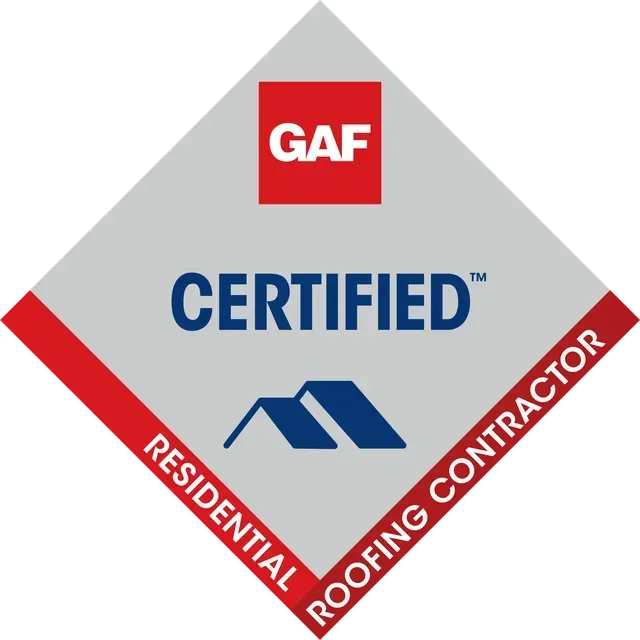
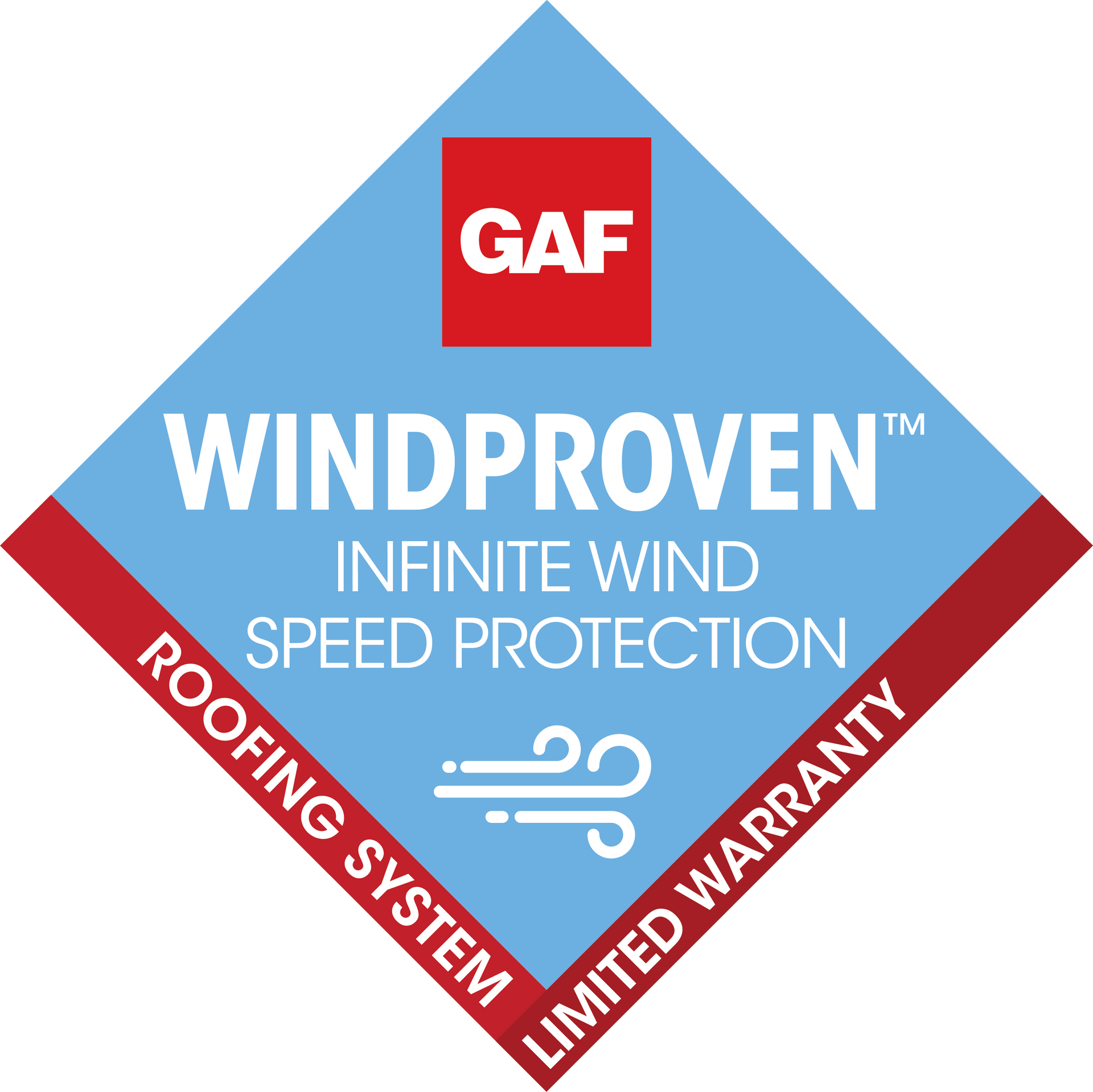
Choosing The Right Roofing Materials For Your Home
Choosing roofing materials for your Pennsylvania home impacts the cost of roof replacement and repairs, but there are many other factors to consider, including aesthetics and durability. It’s beneficial to research roofing materials, learn more about the different options and get expert advice to help you decide which materials are best suited to your project.
Here is some useful information about the most popular materials for new roofs in Pennsylvania:
1. Shingles
From $650 / SQ
Asphalt shingles are one of the most popular choices due to their affordability and availability.
Pros:
- More affordable than other materials
- Easy to access
- Simple installation
- Versatile: Suitable for most projects
- Good fire resistance
- Enhanced Lifetime Warranties Available
Cons:
- Shorter lifespan than other materials (around 30 years)
- May be less aesthetically pleasing depending on personal tastes
- Can be stained by blue/green algae
- Somewhat Prone to Wind & Hail Damage
2. Exposed Fastener Metal Roofing
From $800 / SQ
Ribbed Panel
Metal roofing(aka “Corrugated Metal”) is an exposed fastener system that is popular due to its longevity and impressive durability. Pros and cons include:
Pros:
- Impressive Durability & Energy-efficiency
- Potentially Longer Lifespan (over 50 years)
- Less Prone to Wind & Hail DamageSimple installation
- Can be installed directly overtop shingles *under the right circumstances*
- Modern Appearance
- Color & Finish Warranties Available
Cons:
- High initial outlay: The cost of metal roofing is significantly higher than other options, such as asphalt shingles
- Less affordable: The outlay means that metal roofing is less affordable for Pennsylvania homeowners
- Fastener Replacement & Maintenance Needed Every 10-15 Years
- System/Manufacturer Warranties Unavailable
Want to find out if your roof is a good candidate for metal roofing installed overtop?
Contact us at (570) 648-5414 to schedule your free inspection!
3. Standing Seam Metal Roofing
From $1600 / SQ
Originally designed for commercial settings, standing seam metal roofing has taken hold in the residential marketplace and is rising in popularity amongst new construction houses as well as re-roofing applications. As a concealed fastener system, standing seam metal roofs boast practically impenetrable protection from the elements, superior durability and - without a screw head in sight - standing seam roofing pulls it all together under a sleek appearance that is simply remarkable.
Pros:
- Longevity: Standing Seam Roofs May Last 70+ Years
- Long-term Value For Money
- Extremely Unlikely to be Damaged by Wind or Hail
- Can Help Save on Homeowners Insurance Costs
- Enhanced Lifetime System/Manufacturer Warranties Available
- Color/Finish Warranties Available
- No Exposed Fasteners; Does Not Depend on a Neoprene Washer for Watertight Seal
- No Fastener Maintenance Needed
Cons:
- High material and labor costs make standing seam metal roofing significantly more expensive than other options
- Roof Penetrations, such as skylights & chimneys, as well as other roofing accessories such as snow/ice bars also come with higher costs on a standing seam metal roof
4. Stone Coated Steel Roofing
From $1500 / SQ
Stone-coated steel roofing combines the strength of steel with the elegance of traditional materials like shingles and tiles. Offering top ratings for hail, wind, and fire resistance, these lightweight yet durable roofs withstand extreme weather and are designed to last a lifetime.
Some innovative systems like Tilcor’s CF Shingle are engineered to install directly over existing shingles, eliminating tear-offs to save time and costs. With a concealed fastening system and lifetime warranty, it provides superior performance, aesthetics, and peace of mind.
For unmatched durability, curb appeal, and long-term value, stone-coated steel roofing is a premium choice.
Pros:
- Long-term Value For Money
- Longevity: Stone Coated Steel Roofs Typically Last 40-70 Years
- Extremely Unlikely to be Damaged by Wind or Hail
- Can Help Save on Homeowners Insurance Costs
- Enhanced Lifetime System/Manufacturer Warranties Available
- Concealed Fastener System
- No Fastener Maintenance Needed
- A Variety of Aesthetically Pleasing Finishes Available including Spanish or Mediterranean Clay Tile, Wood Shake Shingle & Architectural Shingle Styles
- Some Systems Designed to be Installed Directly Overtop Shingle Roofs - Can Help Save on Labor and Disposal Costs
Cons:
- High material and labor costs make stone coated steel roofing significantly more expensive than other options
- Roof Penetrations, such as skylights & chimneys, as well as other roofing accessories such as snow/ice bars also come with higher costs on a stone coated steel roof
5. Clay Tile Roofing
From $1400 / SQ
Clay tile roofing offers timeless beauty, durability, and a distinctive Mediterranean-inspired style. Available in various shapes and colors, it complements many architectural designs. With a lifespan of 50–100 years, clay tiles resist fire, rot, and insects, while their natural thermal properties improve energy efficiency by regulating indoor temperatures.
Though heavier than other materials, modern support systems easily accommodate their weight. Ideal for hot climates, clay tiles maintain their vibrant appearance over time, making them a long-lasting and low-maintenance choice.
Pros:
- Durability: Lasts 50–100 years with proper maintenance.
- Fire Resistance: Non-combustible and provides excellent fire protection.
- Weather Resistance: Handles extreme weather, including high winds, heat, and UV exposure.
- Energy Efficiency: Helps regulate indoor temperatures, reducing energy costs.
- Aesthetic Appeal: Timeless beauty with various styles, shapes, and colors.
- Low Maintenance: Resistant to rot, insects, and mildew.
- Eco-Friendly: Made from natural, recyclable materials.
Cons:
- Weight: Heavy tiles may require additional structural support.
- Cost: Higher initial investment compared to other materials.
- Fragility: Individual tiles can crack or break under heavy impact.
- Complex Installation: Requires skilled professionals, increasing labor costs.
- Climate Suitability: Best for hot, dry climates; may struggle in freeze-thaw cycles.
- Limited Retrofit Options: Older roofs may need upgrades to support tile weight.
6. Slate Roofing
From $1500 - $2100 / SQ
Slate roofing is renowned for its beauty and durability, often lasting over a century, but traditional slate is heavy, costly, and labor-intensive. Modern imitation slate, like products from DaVinci Roofscapes and EcoStar Roofing, offers the same classic look with lightweight, high-performance materials at a more affordable price.
Made from engineered polymers or recycled materials, imitation slate is durable, eco-friendly, and easier to install and maintain. Available in various colors and styles, it enhances curb appeal while resisting impact, wind, and fire. With options like lifetime warranties, imitation slate is a practical, cost-effective alternative to natural slate.
Pros:
- Aesthetic Appeal: Replicates the classic, elegant look of natural slate.
- Lightweight: Much lighter than natural slate, often eliminating the need for structural reinforcement.
- Durability: Highly resistant to impact, wind, and fire, with many products offering lifetime warranties.
- Eco-Friendly: Made from recycled or sustainable materials, reducing environmental impact.
- Customizable: Available in a wide range of colors and styles to suit various architectural designs.
- Ease of Installation: Easier and faster to install than traditional slate, reducing labor costs.
- Low Maintenance: Requires minimal upkeep compared to natural slate.
- Lifespan: Imitation slate may not last as long as high-quality natural slate (100+ years) but imitation roof systems typically last 40-80 years
Cons:
- Initial Cost: Far more expensive than asphalt shingles or other common roofing materials.
- Availability: Limited options for certain styles or manufacturers in specific regions.
- Very Expensive to Repair if damaged
7. Cedar Shake Roofing
From $1600 / SQ
Cedar shake roofing combines natural beauty with exceptional performance. Its unique textures and tones weather gracefully over time, adding charm to any home. Durable and long-lasting, cedar shakes can withstand harsh weather for 30–50 years with proper care. Their natural insulating properties help regulate indoor temperatures, reducing energy costs, while cedar’s oils provide resistance to rot, decay, and insects.
Sustainably sourced and impact-resistant, cedar shakes offer a timeless, eco-friendly roofing option that balances style and functionality.
Pros:
- Natural Beauty: Offers a timeless, rustic aesthetic that enhances curb appeal.
- Durability: With proper care, cedar shakes can last 30–50 years.
- Energy Efficiency: Provides natural insulation, reducing heating and cooling costs.
- Weather Resistance: Can withstand harsh weather, including wind, rain, and snow.
- Impact Resistance: Flexible material resists damage from hail and debris.
- Sustainability: Made from renewable resources, often from sustainably managed forests.
- Rot and Insect Resistance: Natural oils in cedar help protect against decay and pests.
Cons:
- Cost: More expensive upfront compared to asphalt shingles or other materials.
- Fire Risk: Cedar shakes are more flammable unless treated or lined with fire retardants.
- Weathering: May fade or darken over time depending on exposure to sunlight and moisture.
- Installation Complexity: Requires skilled labor, increasing installation costs.
- Not Ideal for All Climates: Performs best in moderate climates; excessive moisture can lead to quicker deterioration.
- Limited Availability: High-quality cedar shakes may not be readily available in all regions.
8. Rubber Roofing (EPDM)
From $1300 / SQ
Rubber roofing, commonly made from EPDM (Ethylene Propylene Diene Monomer), is a highly durable and versatile option, especially for flat and low-slope roofs. Known for its flexibility, rubber roofing resists cracking, shrinking, and weathering, making it ideal for areas with extreme temperatures or harsh weather conditions.
One of the key advantages of rubber roofing is its seamless water resistance, effectively preventing leaks and moisture damage. It excels at covering complex roof sections with many nooks, crannies, or penetrations, providing reliable protection in hard-to-reach areas. Additionally, rubber roofing is eco-friendly, often made from recycled materials, and offers energy efficiency to help reduce heating and cooling costs
Pros:
- Weather-resistant
- Durability and longevity: Rubber roofing can last up to 50 years
- Energy-efficient: rubber roofing systems contain a mechanically attached insulation layer below the membrane which adds R-Value to the top of your home
- Elastomeric & Silicone Roof Coating Systems can be installed to further extend the life of rubber roofs but at a fraction of the cost
Cons:
- Higher initial outlay than other low-slope roofing materials
9. Roll Roofing
From $900 / SQ
Roll roofing is a cost-effective and practical option for low-slope or flat roofs, ideal for sheds, garages, and outbuildings. Its affordability and simple installation make it perfect for budget-friendly projects, reducing material and labor costs.
While not as durable as premium materials, roll roofing provides reliable weather protection for short- to medium-term use. Its flexibility allows it to conform to unique roof shapes, offering a secure barrier. For quick and economical roofing needs, roll roofing is an efficient and functional solution.
Pros:
• Affordable: One of the most cost-effective roofing materials available.
• Easy Installation: Quick and simple to install, reducing labor costs.
• Lightweight: Minimal stress on roof structures, ideal for smaller buildings.
• Flexible: Can conform to unique roof shapes, especially on low-slope roofs.
• Weather Protection: Provides reliable short- to medium-term protection against water and weather.
• Ideal for Small Projects: Perfect for sheds, garages, back porch roofs and temporary structures.
Cons:
• Limited Durability: Shorter lifespan compared to premium roofing materials.
• Aesthetic Limitations: Offers a basic, utilitarian appearance.
• Not Suitable for Steep Slopes: Designed specifically for flat or low-slope roofs.
• Less Resilient: Prone to tearing and damage from extreme weather or impacts.
• Maintenance Requirements: May need more frequent repairs and upkeep.
• Lower Resale Value: Not ideal for homes where curb appeal or long-term value is a priority.
10. Built Up Roofing (BUR)
From $1200 / SQ
Built-up roofing (BUR) is a durable and time-tested option for flat and low-slope roofs, commonly used on commercial buildings but also suitable for residential applications. It is constructed by layering alternating sheets of bitumen (asphalt or tar) and reinforcing fabrics, topped with gravel or a reflective coating. Built-up roofing combines durability, energy efficiency, and low maintenance, making it an ideal choice for those seeking reliable and long-lasting protection for flat or low-slope roofs. This multi-layered system provides several key benefits:
Pros:
- Durability: Withstands harsh weather, UV rays, and water infiltration.
- Seamless Protection: Creates a continuous, watertight barrier to minimize leaks.
- Longevity: Can last 20–30 years or more with proper maintenance.
- Low Maintenance: Resists damage from foot traffic and debris, requiring minimal upkeep.
- Energy Efficiency: Gravel or reflective coatings help regulate roof temperature and improve energy efficiency.
- Customizable: Can be tailored with fire-resistant or reflective top layers to meet specific needs.
- Proven Performance: Time-tested system with a long history of reliability.
Cons:
- Installation Time: Requires multiple layers, making the process longer than some other systems.
- Weight: Heavier than many other roofing options, which may require additional structural support.
- Initial Cost: Higher upfront costs due to labor-intensive installation.
- Limited Slope Use: Not suitable for steep-sloped roofs; designed for flat or low-slope applications.
- Odor During Installation: Bitumen materials can produce strong odors during application.
- Weather Sensitivity During Installation: Requires dry conditions and specific temperatures for proper installation.
Which Roofing Material Is Right For Me?
There is no universal answer to the question, ‘Which is the best roofing material?’ as every property is different and homeowners have varied requirements and preferences. To help you decide which material is best for your home, it’s beneficial to explore all the options, compare the pros and cons, get quotes and seek expert advice. Experienced, reputable roofing contractors will be able to offer tailored advice and recommendations based on your roof, the type of repairs or installation required, your budget, and your priorities.
When you compare roofing materials, consider all the factors, including short and long-term costs, durability, aesthetics and ease of installation. You can then consider the advantages and disadvantages and relate them back to your property and your preferences. Some homeowners, for example, may want to choose the least expensive materials because they plan to move or they’re on a tight budget. Others may want to prioritize longevity or aesthetics, which may mean spending more on materials. In other cases, experts may recommend specific materials due to the nature, size or complexity of the replacement.
If you have any questions about roofing materials, it’s an excellent idea to seek professional advice. This will give you clarity and help you narrow down the options.
Tips To Save Money On Your New Roof
Every homeowner wants to get the best possible deal on home repairs. To help you save money on your new roof, here are some top tips:
1) Take action early: It’s often much more cost-effective to tackle minor repairs than to leave your roof to deteriorate.
2) Consider scheduling work late-season: Labor costs peak during the warmer months when the demand for roofing contractors increases. If you can, schedule work at the end of fall/start of winter to reduce costs.
3) Investigate financing options: In some cases, customers can benefit from financing options, which help to spread the cost of a new roof, making it more affordable. Ask your contractor about finance plans before you commit. It’s important to make sure you can afford the repayment costs before you sign any agreements.
4) Check your insurance: Before you invest money in roof replacement, check your insurance. You may be covered if your home was damaged as a result of a storm, for example.
5) Compare several quotes: It’s always a good idea to get several quotes from reputable, highly rated contractors.
Expert Roof Repair & Roof Replacement Services From Rob's GC
Rob’s General Contracting specializes in roof repairs, new roofs in Pennsylvania and storm damage restoration, providing expert roofing services for customers in Central Pennsylvania. Established over 30 years ago - originally "Rob's Roofing" -Rob’s GC is a leading name in roofing, siding, gutter installation and storm repairs.
If you need help or advice about roof replacement or roof repairs in Pennsylvania, or you have questions about the cost of a new roof, our experienced, professional team is on hand to help.
At Rob's General Contracting we've been building roofing expertise since 1992 - Originally Rob's Roofing
What sets us apart?
At Rob’s GC, we are experts at roof repairs and storm damage remediation,
but what sets us apart is our commitment to delivering excellent customer service.
We approach each job with energy and enthusiasm, working efficiently and diligently to complete each task with precision, detail and finesse,
but we also strive to ensure every customer enjoys an outstanding experience. It’s critical to us that our clients would feel comfortable recommending our business to their nearest and dearest.
We are proud to have an excellent reputation across Central and Northeastern Pennsylvania
- Over 30 years of hands-on experience
- Certified Roofing & Siding Experts, delivering first-class craftsmanship and offering Lifetime Warranties
- Flexible payment options
- Approachable team
- Customer-centered focus
- Competitive, transparent pricing
- High-quality results that will add value to any Pennsylvania home or business
Conclusion
The cost of a new roof in Pennsylvania varies, according to key factors, such as the size of the roof, the roof design, the materials you choose, and where you live. Typically, homeowners in PA can expect to pay between $10,000 and $30,000 for roof replacement, but this figure may be significantly higher, depending on the size of your roof, the complexity of the project and the type of roofing materials you choose. Data shows that average prices for asphalt shingle roof replacement reached over $1,000/SQ in the US in 2024; meanwhile it is suggested that shingle roof replacement costs in Pennsylvania come in around $750/SQ on average. To get an accurate idea of average roof costs, it’s beneficial to compare multiple quotes from experienced, reputable
roofing contractors.
Frequently Asked Questions (FAQ)
How much does a new roof cost in Pennsylvania?
The average roof cost in Pennsylvania can vary hugely from less than $10,000 for some projects to more than $35,000. The total cost of roof replacement will depend on several factors, including the size and shape of your roof, the complexity of the roof design, the materials you choose, labor costs, and your location within the state. Asphalt Shingles are the most common type of residential roofing material and the average cost to replace a shingle roof in Pennsylvania is estimated to be around $10,000.
Which factors affect the cost of roof replacement in PA?
The main factors that affect the cost of roof replacement in Pennsylvania include the size of the roof, the cost and availability of the materials you use, the expertise and experience of your contractor, your location (prices tend to be higher in big cities) and the scope of the quote.
Which roofing materials are best?
There are pros and cons to using every type of roofing material. Slate, metal and tiles are popular due to their durability and aesthetic appeal while asphalt shingles are an affordable choice. It’s beneficial to weigh up the pros and cons, compare prices and consider the requirements of your project before you decide. It’s also wise to seek professional advice from reputable roofing contractors to get tailored recommendations and quotes.
How can I ensure the best results when replacing my roof?
The best way to guarantee impressive results when replacing your roof is to choose an experienced, professional, reputable roofing contractor. Research roofing companies on social media, read verified reviews and ask people you know for recommendations. Always select companies or contractors that are licensed and insured and be sure to ask if they offer any roof warranties.
What is the most expensive roofing material?
Slate is widely regarded as the most expensive roofing material. Natural slate tiles are crafted from stone, offering unmatched durability and a lifespan of over 100 years. Their luxurious appearance and exceptional longevity come at a high cost, with prices often exceeding $20 per square foot for materials alone, plus additional costs for specialized installation. That being said, it's more practical now to install imitation slate roofing - which is less expensive compared to real slate.
Other premium options like Terra Cotta Tiles, Cedar Shakes, and high-end metal roofing systems such as standing seam or stone coated steel can be just as costly.
What are the different types of asphalt shingles?
There are three main types of asphalt shingles, each offering distinct advantages:
- 3-Tab Shingles: These are the most basic and affordable option, featuring a flat, uniform appearance with evenly spaced tabs. They’re lightweight and suitable for budget-conscious projects but have a shorter lifespan (typically 20–30 years) compared to other types.
- Architectural (Dimensional) Shingles: These are thicker and more durable than 3-tab shingles, with a layered, dimensional appearance that mimics the look of wood or slate. They offer improved wind and weather resistance, lasting 30–50 years, and are the most popular choice for residential roofing.
- Designer/Luxury Shingles: These are the highest-quality asphalt shingles, designed to replicate the appearance of premium materials like slate or cedar shakes. They’re heavier, more durable, and provide exceptional curb appeal and weather protection, though they come at a higher cost.
Each type of asphalt shingle offers different benefits, allowing homeowners to choose based on their budget, aesthetic preferences, and durability needs.
What are some examples of designer or luxury shingles?
There are 3 different
Lifetime Designer Shingles available in Pennsylvania from GAF:
Camelot II
Camelot® II Shingles complete a home with their classic artisan-crafted, slate-like appearance; plus they are specially colored with a custom palette that conjures the romance of European architecture.
Woodland
Woodland® Shingles give the stylish look of hand-cut European shingles with 21st century style - and at only a fraction of the cost of traditional slate or wood shakes
Slateline
Slateline® Asphalt Shingles feature bold shadow lines and tapered cut-outs to create the appearance of slate at only a fraction of the cost of traditional slate.
When is the best time of year to get a new roof installed?
The best time to install a new roof is often in late fall. During this time, temperatures are cool but not freezing, which is ideal for roofing materials and adhesives to set properly. Additionally, late fall weather typically features fewer storms compared to earlier in the season, making conditions more predictable for roofing projects.
Roofing contractors may also have greater availability in late fall as the peak busy season of summer and early fall winds down. This can make it easier to schedule your project
and may even result in more competitive pricing. While roofing can be done year-round, late fall often offers the perfect balance of favorable weather and contractor availability for a high-quality, efficient installation.
Should I consider lifespan when choosing a new roofing material for my home?
The lifespan of a roofing material is a key factor in determining the long-term value and durability of your investment. Choosing a roofing material with a longer lifespan means fewer replacements over the years, saving you money on future labor and materials.
A longer-lasting roof can also increase your home’s value and provide peace of mind, especially if you plan to stay in your home for many years or want to leave a reliable roof for the next owner. Additionally, durable materials like slate, metal, or tile often require less maintenance, further reducing costs over time.
While materials with shorter lifespans, like asphalt shingles, may have a lower upfront cost, they’ll likely need replacement sooner, potentially costing more in the long run. Considering the lifespan of a roofing material ensures you make a choice that balances your budget, future needs, and the overall durability of your home’s roof.
How long will it take to replace my roof?
In most cases, a day.
Can we put a new roof in during winter?
Yes, you can get a new roof installed during winter! While winter roofing presents some challenges, experienced contractors are equipped to handle cold-weather installations effectively. Asphalt shingles, for example, can still be installed, but care must be taken to ensure proper sealing, as adhesives may take longer to set in colder temperatures.
Winter roofing projects often come with benefits, such as greater contractor availability and potentially quicker scheduling, as it’s typically a less busy time of year for roofing companies. However, extreme conditions like heavy snow or ice may cause temporary delays.
If you need a roof replacement in winter, working with a skilled roofing contractor ensures a safe and successful installation despite the colder weather.
Request Roofing Services or Storm Damage Restoration Online and Get a Rapid Response from a Project Manager!
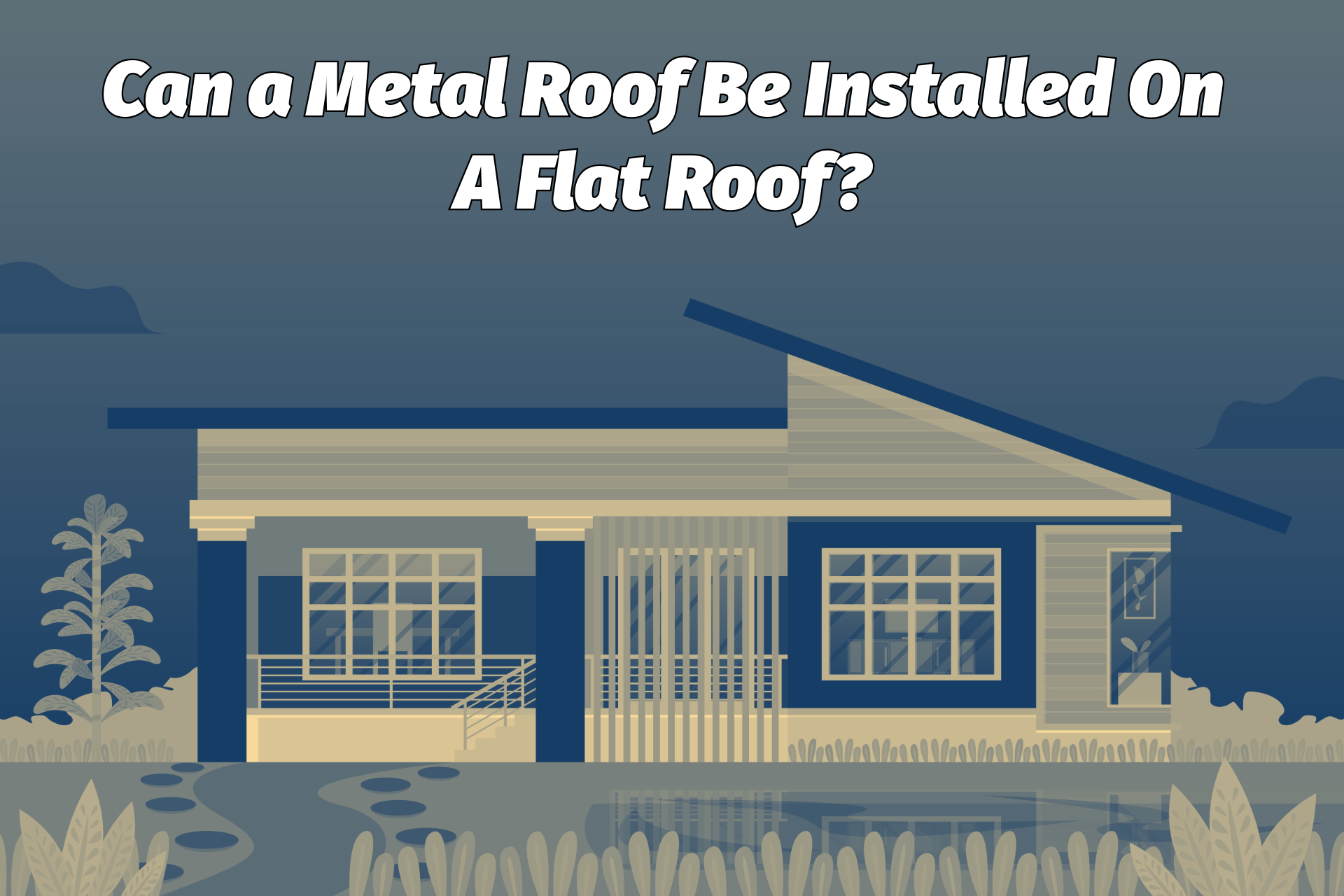
BROWSE OUR WEBSITE









CashApp
CONTACT INFORMATION
Phone: (570) 648-5414
Email: info@robsgc.com
Address: 257 South Market St., Shamokin, Pennsylvania 17872
Business Hours
- Mon - Sat
- -
- Sunday
- Closed
24-hour emergency
OUR LOCATION

